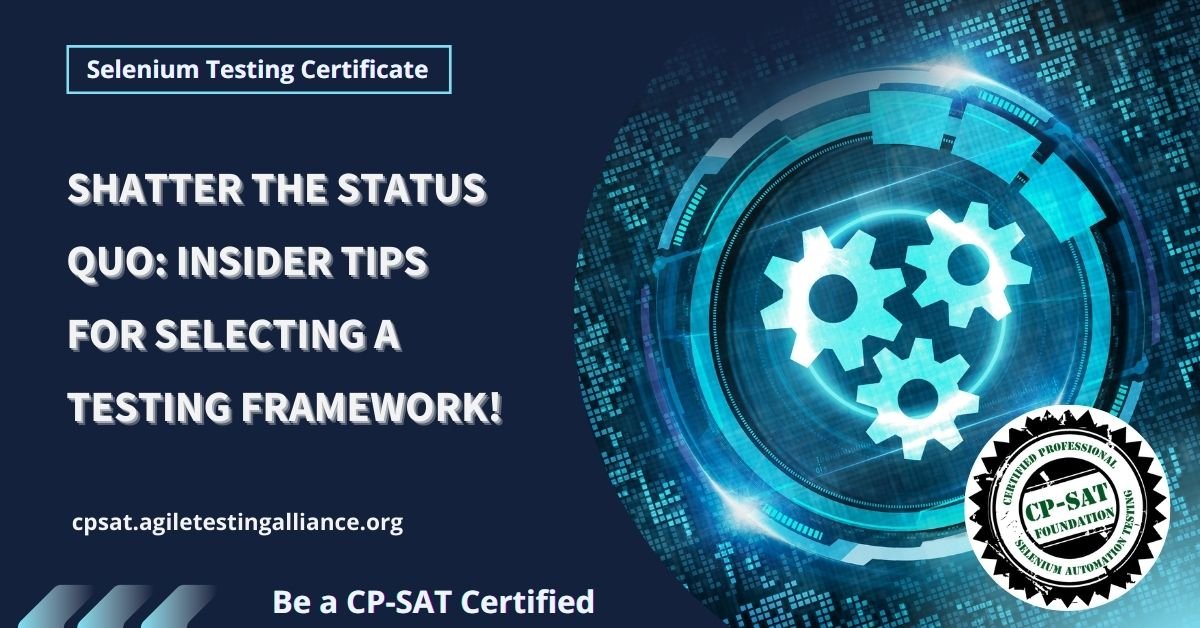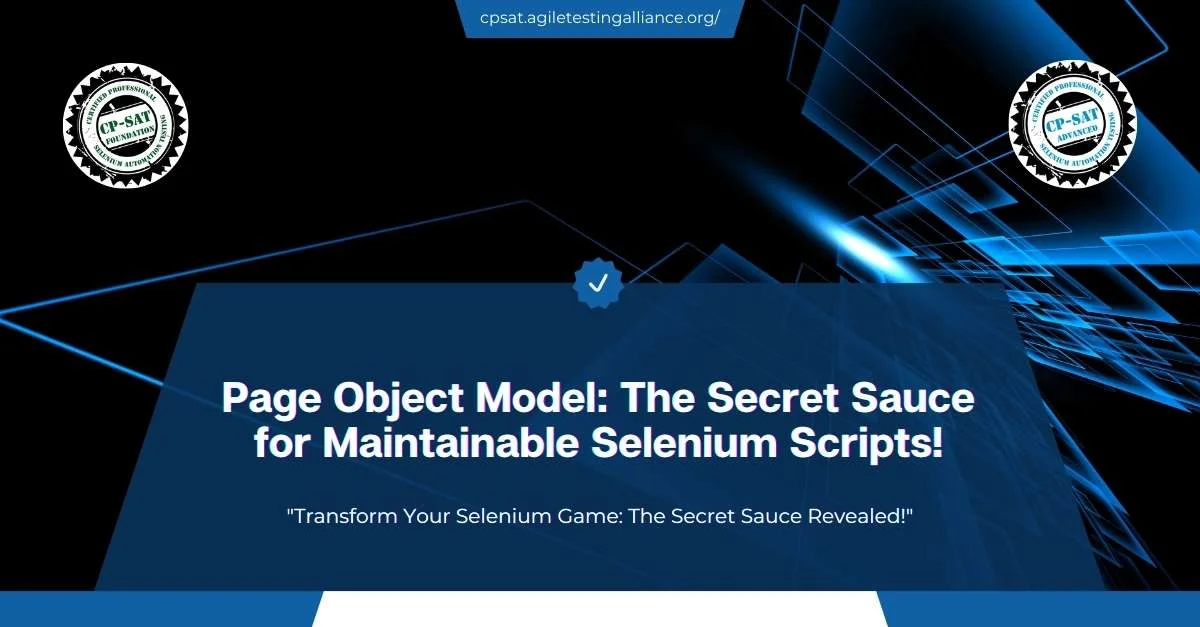
Shatter the Status Quo: Insider Tips for Selecting
a Testing Framework!

Table of Contents
Introduction: The Framework Conundrum
Welcome to the enthralling world of software testing, where the landscape is as dynamic as the applications we test. But here’s a riddle that even seasoned professionals grapple with: How do you choose the right testing framework? The answer isn’t as straightforward as you’d hope. In fact, the framework you select can either catapult your testing strategy to new heights or bog it down in a quagmire of inefficiency.
So, let’s set the stage. A testing framework isn’t just a bunch of libraries or tools; it’s the backbone that aligns your testing with business objectives. Selecting the wrong one is like building a skyscraper on a shaky foundation—sooner or later, it’s going to crumble. That’s why it’s crucial to look beyond the marketing buzzwords like “user-friendly” or “feature-rich” and delve into what really matters.
From a global perspective, the importance of choosing the right framework cannot be overstated. As businesses are scaling and expanding into new markets, the need for a robust, flexible, and scalable testing framework is paramount. Your choice impacts not just the QA team, but the entire software development lifecycle, affecting everyone from developers to stakeholders.
Now, why is this such a conundrum? First, there’s no one-size-fits-all solution. Whether you’re leaning toward JUnit for its Java compatibility or considering TestNG for its advanced configurations, your choice will largely depend on your project’s specific needs and your team’s expertise. Moreover, with technology evolving at a breakneck speed, what works today might not be the best fit tomorrow. The introduction of cloud-based solutions, containerization technologies like Docker, and AI-powered testing tools further complicate the decision-making process.
In this comprehensive guide, we will unravel the complexity surrounding this crucial choice. From essential criteria and comparative analyses to real-world case studies and future trends, you’ll gain a holistic understanding of how to shatter the status quo and select a framework that’s a perfect fit for your global software testing needs. So fasten your seatbelts; it’s going to be an enlightening ride.
The Essential Criteria
Let’s jump right in, shall we? When it comes to pinpointing the ideal testing framework for your global team, there are certain non-negotiables that you simply cannot ignore. These are the linchpins that hold your testing strategy together and provide a foundation for scaling and improving your processes. So, without further ado, let’s dive into these game-changing criteria.
1. Language Compatibility
First and foremost, let’s talk about programming languages. Whether you’re a fan of Java, madly in love with Python, or staunchly loyal to C#, your framework should seamlessly align with the language of your choice. This ensures that your developers and QA engineers can quickly adapt to the framework, thereby shortening the learning curve and accelerating the testing cycle.
2. Community Support
An often overlooked yet critical factor is the vibrancy of the framework’s community. The larger and more active the community, the quicker you can find solutions to your nagging problems. From stack overflow threads to GitHub repositories, community support serves as a lifeline when you’re stuck in the trenches.
3. Extensibility
Next up is extensibility. Your chosen framework should be flexible enough to adapt as your testing needs evolve. This is especially crucial in today’s fast-paced Agile and DevOps environments where quick iterations are the norm. An extensible framework will let you plug in additional tools, libraries, or even bespoke modules with ease.
4. Reporting Features
Data is king; we all know that. But what’s the point of collecting mountains of test data if you can’t decipher it? Comprehensive reporting features are a must-have. From simple pass/fail indicators to complex analytics and insights, a good framework will equip you with the tools you need to make data-driven decisions.
5. Parallel Execution
Last but certainly not least, parallel execution capabilities are indispensable in today’s world of continuous delivery. The ability to run multiple tests concurrently not only speeds up the process but also enhances efficiency. With the increasing adoption of Selenium Grid and cloud-based solutions, parallel testing is fast becoming a cornerstone of modern testing.
In a nutshell, the ideal testing framework should be a potent mix of these five criteria. If you’re aiming for a truly global impact, these criteria transform from “nice-to-haves” to “absolutely essential.” So, as you navigate through the labyrinth of options, keep these essential criteria at the forefront of your decision-making process.
Top Contenders in the Arena
The moment you’ve all been waiting for—the grand reveal of the top contenders in the testing framework arena. The landscape is rife with options, but only a few emerge as true champions when evaluated against our essential criteria. So, let’s roll up our sleeves and dive right in, shall we?
1. JUnit: The Java Juggernaut
If you’re a Java aficionado, JUnit should already be on your radar. It’s the go-to framework for Java-based testing and boasts incredible community support. What makes it a standout? Its annotations make test configuration a breeze, and its compatibility with tools like Selenium Grid and Jenkins catapults it into a league of its own. JUnit has undergone several iterations, and its latest version, JUnit 5, has expanded its extensibility features, making it a formidable contender.
2. Pytest: Python’s Crown Jewel
Python enthusiasts, meet your match—Pytest. Known for its simplicity and ease-of-use, Pytest offers native support for parallel testing through its pytest-xdist plugin. Its assert-based reporting gives you crystal-clear insight into what went wrong and why. Oh, and did I mention its robust community support? A must-try for anyone engrossed in the Python ecosystem.
3. TestNG: When Java Needs More
Stepping up to the plate is TestNG, designed to cover all categories of tests, including unit, functional, and end-to-end. Originating from JUnit, TestNG introduces new functionalities, such as test configuration and parallel execution, which amplifies its appeal to Java developers.
4. NUnit: C#’s Gem
For those leaning toward the .NET world, NUnit serves as a compelling alternative. It offers exceptional support for parallel execution and its strong tie-ins with Selenium Grid and CI/CD pipelines make it a solid choice for large-scale projects.
5. Mocha: The JavaScript Virtuoso
Last but certainly not least, for those riding the JavaScript wave, Mocha is your knight in shining armor. With its ease of setup and extensive library support, it’s a JavaScript developer’s dream come true. Rich reporting and extensibility seal the deal, making it a top choice for web-based projects.
To sum it up, each framework comes with its unique set of features and advantages, but the real question is which one aligns best with your project needs and overarching goals. So, take your pick, but make it wisely.
Pros and Cons: A Comparative Analysis
Let’s pivot and dissect the nuanced pros and cons of these top-notch frameworks. At this juncture, you might be tempted to latch onto one based on reputation or community support, but let’s look under the hood to see what really sets them apart. By the end of this section, you’ll have a crystal-clear road map for choosing the framework that most suits your needs.
1. JUnit: Pros and Cons
Pros:
- Effortless Test Configuration: With JUnit, you can sail through test setups and teardowns like a breeze, thanks to its intuitive annotation system.
- CI/CD Friendly: JUnit seamlessly integrates with Jenkins and other CI/CD pipelines, essentially becoming the backbone of any automated testing strategy.
Cons:
- Java-Centric: If your team isn’t well-versed in Java, then JUnit could pose a steep learning curve.
- Limited Functionality: While its simplicity is an advantage, it can also be a drawback when dealing with more intricate test requirements.
2. Pytest: Pros and Cons
Pros:
- Assert-based Reporting: The clarity of its assert-based failure reports is second to none, offering insights that are both detailed and easily digestible.
- Extensibility: With a plethora of plugins, extending Pytest’s capabilities is a piece of cake.
Cons:
- Python-Only: Just like JUnit leans heavily on Java, Pytest is confined to the Python ecosystem.
- Initial Complexity: The range of features might overwhelm new users at first glance.
3. TestNG: Pros and Cons
Pros:
- Highly Configurable: XML-based configuration options make TestNG remarkably flexible.
- Parallel Execution: When it comes to running tests concurrently, TestNG truly excels, offering built-in parallel execution features.
Cons:
- Steep Learning Curve: TestNG has a multitude of options, which can be daunting for beginners.
- Lack of Community Support: Although gaining traction, it doesn’t yet match the community support of JUnit or Pytest.
4. NUnit: Pros and Cons
Pros:
- Attribute-based Configuration: NUnit makes it easy to create complex test scenarios with its attribute-based approach.
- Robust Assertions: Its assert capabilities are highly versatile, allowing for an expansive range of test validations.
Cons:
- Limited to .NET: NUnit’s primary constraint is that it’s tailor-made for the .NET ecosystem.
- Tooling: While functional, the tooling around NUnit isn’t as rich as some of its competitors.
5. Mocha: Pros and Cons
Pros:
- Easy Setup: Mocha’s minimal configuration needs make it particularly appealing for JavaScript newbies.
- Asynchronous Testing: It offers excellent support for testing asynchronous code, a real boon in today’s web-based projects.
Cons:
- JavaScript Only: Being tied to JavaScript, it may not be the ideal choice for those venturing beyond the JS world.
- Limited in Scope: Mocha focuses on test basics, so you might need to reach for additional libraries for more advanced requirements.
So, go ahead, let this serve as your compass as you venture forth into the world of software testing frameworks. Choose wisely and test effectively!
Lessons from Real-World Adoption
So, we’ve delved into the technical nitty-gritty of these frameworks, but how do they actually perform when the rubber meets the road? Buckle up as we embark on an illuminating journey through real-world experiences with these frameworks. By drawing from a wealth of case studies and user testimonials, we’ll uncover the hidden truths you won’t find in any official documentation.
JUnit: The Reliable Old Guard
JUnit has been around for years, cementing its status as a reliable workhorse in various enterprises. Case studies reveal an astonishing compatibility with legacy systems, making it a go-to for those dealing with older Java-based applications. However, the downside? A noticeable lag when adapting to cutting-edge technologies. If you’re focusing on being on the forefront of tech innovations, you might feel a bit constrained.
Pytest: The Agile Innovator
The Python community has embraced Pytest for its agility and speed. Startups, especially those in the AI and data analytics fields, find its rapid test execution and flexible configurations ideal for quick iterations. The downside is that Pytest might require more hardware resources for complex test scenarios, so plan your infrastructure wisely.
TestNG: The Enterprise Darling
Large organizations with complex workflows have found solace in TestNG’s scalability and comprehensive reporting features. Its rich functionality is a boon for extensive test scenarios, but it does come at the cost of initial setup complexities. It’s a framework built for the long haul, but that longevity requires an upfront investment of time and resources.
NUnit: The .NET Dynamo
Businesses deeply entrenched in the Microsoft ecosystem often lean towards NUnit for its seamless .NET integration. Real-world case studies applaud its robustness but caution against a somewhat steep learning curve and limited cross-platform capabilities.
Mocha: The JavaScript Powerhouse
In the fast-evolving world of web development, Mocha stands out for its simplicity and effectiveness in testing JavaScript code. With the explosion of Node.js and various front-end frameworks, Mocha has proven to be invaluable. However, its JS-centric approach could be limiting if you aim for a more polyglot development strategy.
By now, it’s abundantly clear that there’s no one-size-fits-all solution. Your choice should hinge on specific project requirements, team expertise, and long-term goals.
In summary, understanding these frameworks through the lens of real-world adoption can help you sidestep pitfalls and make an informed decision. After all, knowing the rules of the game is halfway to winning it.
The Bigger Picture: Integrations and Ecosystem
Alright, folks, let’s zoom out a bit and take a look at the grand canvas. It’s not just about picking a testing framework that meets your immediate needs. You also need to consider how seamlessly the framework integrates with your existing tech stack and the broader ecosystem of tools you rely on. After all, no framework is an island.
Integration with Version Control Systems
When it comes to integration with version control systems like Git, most frameworks offer straightforward options. Yet, frameworks like JUnit and TestNG, for example, are often easier to hook up to enterprise-grade version control systems, giving them an edge in “source code management”.
Compatibility with Build and Deployment Tools
If you’re deeply invested in a Continuous Integration/Continuous Deployment (CI/CD) pipeline using tools like Jenkins or GitLab CI, you’ll need a framework that plays well in this space. TestNG and NUnit often come out on top for “automated build pipelines” in complex, multi-stage deployments. Pytest shines in containerized environments, offering superb compatibility with Docker and Kubernetes.
Extensibility and Plugin Architecture
Perhaps you require specialized reporting or have to hook into a unique database for your test data. Mocha and Pytest provide a rich ecosystem of plugins and extensions. This “framework extensibility” allows you to adapt the framework to your specific needs rather than contorting your needs to fit the framework.
Performance Monitoring
Your framework needs to do more than just pass or fail tests. It should provide insightful metrics about performance. Tools like TestNG and NUnit offer robust “performance monitoring capabilities”, helping you ensure that your applications not only work but also work efficiently.
The Cloud Perspective
Last but not least, how cloud-ready is your testing framework? With cloud computing now a cornerstone of modern enterprise architecture, your framework needs to be more than cloud-compatible; it should be cloud-native or at least offer seamless “cloud integration”.
Keep in mind that your choice of a testing framework isn’t just about immediate needs; it’s a long-term strategic decision. Select a framework that not only ticks off your current list but also aligns with your future goals and seamlessly integrates with your broader technology landscape. In the ever-evolving tech world, this level of foresight is not just beneficial; it’s essential.
Conclusion: Beyond the Status Quo
So, we’ve navigated through the labyrinth of selecting a testing framework, examining not just the features but also the larger ecosystem and the potential for seamless integrations. As we draw this discussion to a close, let’s reframe our initial question. It’s not merely about which framework is the “best”; it’s about which one is the best for your unique requirements and future aspirations. We’ve moved “beyond the status quo” in testing frameworks, and it’s time you do the same.
A Paradigm Shift
Gone are the days when choosing a testing framework was a tactical decision made by a single team. In today’s interconnected, cloud-driven world, this choice has evolved into a strategic move that impacts multiple facets of your organization. So, don’t just focus on “test execution speed”; consider the framework’s potential to serve as an integral part of your DevOps cycle and its compatibility with “global best practices”.
The Inevitability of Change
Remember, the tech landscape is ever-changing. The tools and frameworks that are industry leaders today may not hold the same position tomorrow. Your framework choice should offer room for adaptability and evolution, or else you run the risk of obsolescence. That’s why you should always keep an eye on “innovation in testing” when making your decision.
Make the Leap, but Be Prepared
Taking the plunge into a new testing framework is not without its challenges. Adequate training, a planned transition, and robust community or vendor support can make a world of difference in how smoothly you make the shift.
Final Thoughts
At the end of the day, shattering the status quo is about fostering a culture of continuous improvement. Choose a testing framework that aligns with this ethos, and you won’t just survive in this competitive landscape—you’ll thrive.
So, as you look toward a future where software quality is not just a goal but a continuous journey, arm yourself with a framework that serves as a reliable compass. Your future self will thank you for the strategic foresight.
There you have it, the road ahead is promising and full of opportunities for those willing to adapt, innovate, and transcend the status quo. And as always, stay ahead of the curve and keep pushing the boundaries of what’s possible in software testing.
FAQs
First things first, there’s no one-size-fits-all answer. A ‘good’ framework is contextual, depending on your project requirements, team skill sets, and long-term objectives. However, “scalability,” “community support,” and “integration capabilities” are some of the overarching qualities to look for.
The eternal debate! Both have their merits. Open-source frameworks usually provide a vibrant community and greater customization. Commercial frameworks offer professional support and are often “ready-to-use”. Your decision here should align with your specific needs and budget constraints.
A well-chosen framework will naturally slot into your DevOps processes, complementing your CI/CD pipeline. Look for frameworks that have built-in features for CI/CD integration and offer robust reporting capabilities.
Time is money, and you don’t want to spend an eternity mastering a new framework. Take into consideration the availability of documentation, tutorials, and an active community. These factors can drastically reduce the time needed to get your team up to speed.
The short answer? Probably not. While there are frameworks that offer a multitude of features, each has its own set of strengths and weaknesses. Often, you’ll find that a combination of frameworks gives you the flexibility to address “complex testing scenarios”.
Mobile testing is no longer a niche; it’s a necessity. When selecting a framework, consider its adaptability to mobile platforms and whether it can seamlessly handle “cross-platform testing”.
Given the ubiquity of cloud services, your chosen framework should ideally be “cloud-compatible”, allowing you to scale effortlessly and make the most of cloud-based resources.














